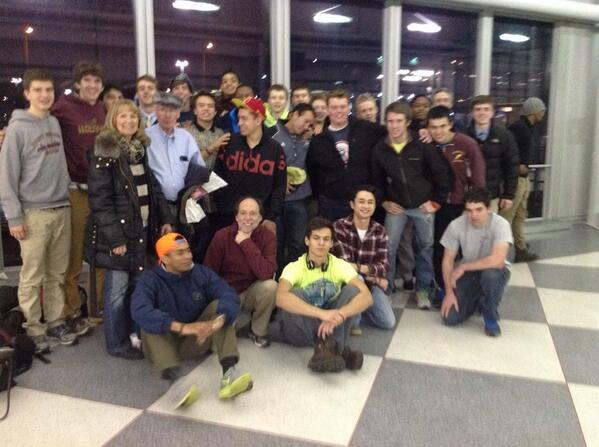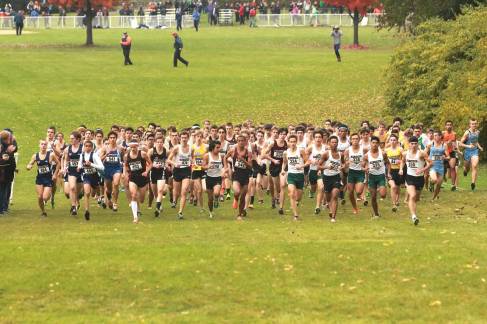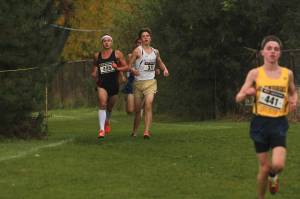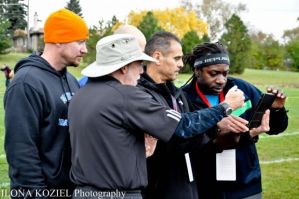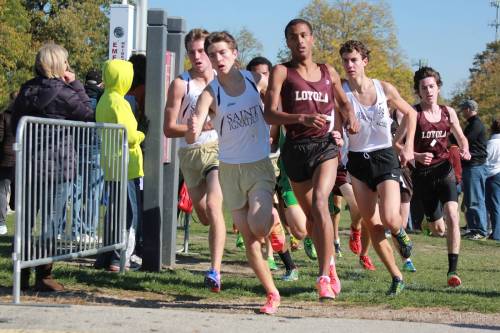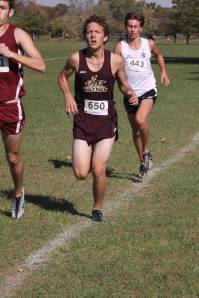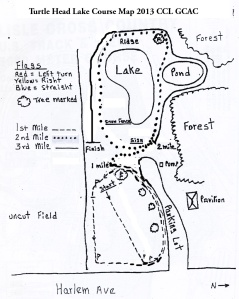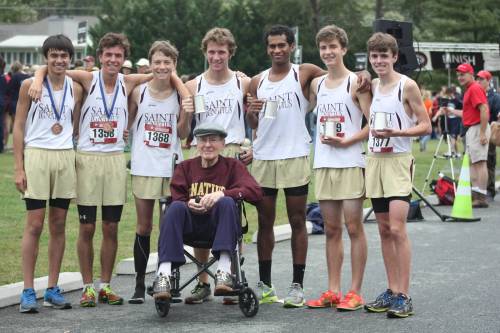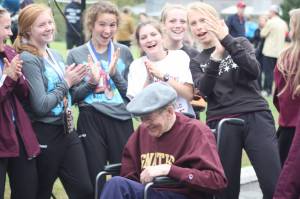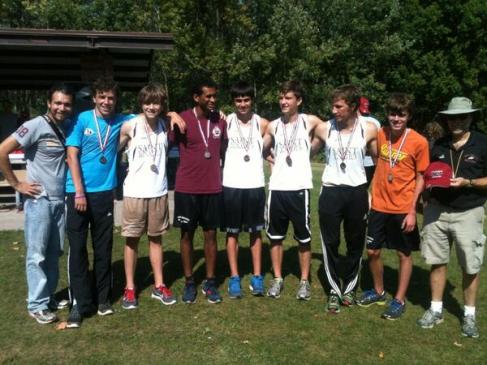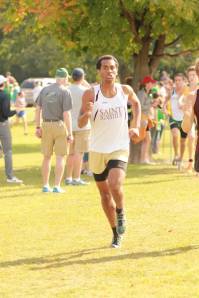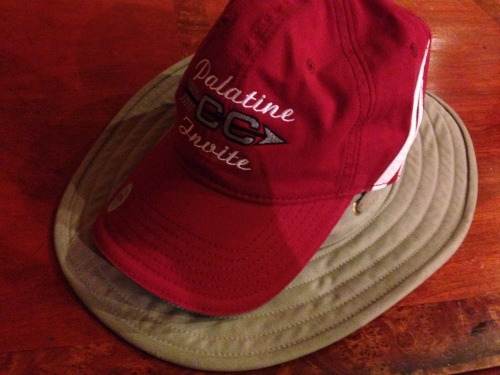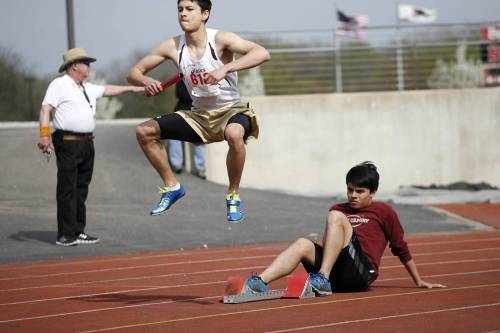
After 16 of 18 events, the Saint Ignatius Wolfpack boys track team sits third–with an IHSA state trophy heartbreakingly close. But it wasn’t to be.
As we prepared for the prelims at the state meet on Friday, I got a report of someone who had read my blog post about our state meet prospects and got the impression that I thought we could win the state meet. Well, I don’t think I said quite that.
But the reader was right. We went into the meet with the hope we could win a trophy.
Since last winter, in fact, our Saint Ignatius team members have been telling ourselves that we had a chance at a trophy at the IHSA 3A state meet. We felt our top runner Jack Keelan could win both the 1600- and 3200-meter runs, which would start us off with 20 points. If we could find ten to fifteen more points, we reasoned, we might have a shot at the podium. It turned out that we would have needed 11 more—and we got only eight.
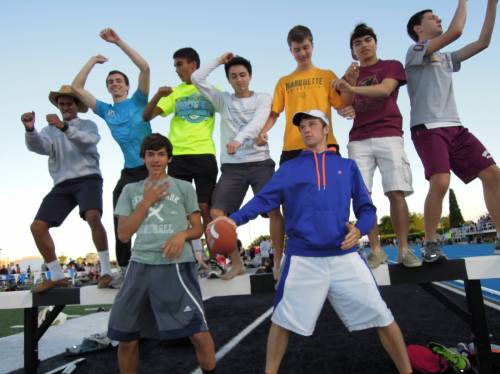
On Friday night at the Race at State meet, the Wolfpack boys shake it out. Photo by Steven Bugarin.
For more than three hours on Saturday at the state meet, including hours after the meet had finished on the track, we were on the podium—after 4 events, then after 13 events, and then even after 17 events with one to go. But we finally finished in a tie for fourth with 28 points, the best performance ever by our Saint Ignatius boys track team—and heartbreakingly close to a trophy.
The final results show Lake Park in first place with 63 points, our Chicago Catholic League rival Providence Catholic second with 33, Pekin third with 31—and Saint Ignatius College Prep and Grant-Fox Lake tied for fourth with 28.
With storms threatening the Charleston area, the IHSA meet organizers made an early decision to run the meet on an accelerated schedule. Rather than stick to a stately schedule that would begin at 11:00 AM and then conclude at 5:00 with team awards, events would run quickly one after another. As a result, the track events were over at 2:30 in the afternoon—more than two hours early.
There was, indeed, some rain—but never any storm serious enough to threaten a delay. The slick conditions did require the high jump for 2A and 3A and the 3A pole vault to be moved indoors to the field house. The speedy track meet and the delay in getting those events underway meant that they continued for two hours after the conclusion of the track events.
It also meant tears for some competitors. Boys do cry when officials won’t let them run because they get to the tent too late. The meet moved alarmingly quickly—30 minutes ahead of schedule by the third event, the 3200-meter run. Coaches and athletes who were not paying careful attention missed their check-ins at the tent, perhaps because they were following the original schedule—and perhaps because the meet just moved more quickly than anyone could imagine it could.

The Wolfpack 4×800 team Elliot Gibson, Andrew Reardon, Sean Kampe, and Chris Korabik after qualifying on Friday. Photo by Steven Bugarin.
It is possible to miss an event on the normal schedule. The scheduled time for the 4×800 meter relay, the first event of the day at 11:00 AM, never changed. I was sitting with our 4×800 team in the field house at 10:30 AM and then watched them all disappear into the locker room where the toilets are located. Time passed, and they seemed to be a long time. Loudspeaker calls– “All 4×800 teams to the tent”– began to get serious. You can’t hear the calls in the locker room. More time passed. Had the boys somehow gone from the locker room directly to the tent? I jogged the quarter mile or so over to the tent. I heard the check-in official tell another official, “We’re still missing Arlington Heights Hersey and Chicago Saint Ignatius.” Another coach there was talking about how the technical rule for the day was that 3A competitors were required to be in the tent when the 1A competitors were running onto the track for the same event.
I sprinted back to the field house, running right past my wife Peggy who had arrived to watch the meet.
Three members of our team were waiting for the fourth to come out of the locker rooms. “Get to the tent!” I yelled at them. They grabbed their things and ran out of the field house. The fourth member of the team re-emerged—and after he collected his spikes and bag, I chased him to the tent. I’m not sure that we met the technical rule, but the door official let him into the tent with his teammates.
This was for the first event of the day, at a time on the posted schedule. As the day progressed and the meet sped up, many other athletes were not as fortunate.
We had rearranged the order for our 4×800 from the prelims. We had set a school record of 7 minutes 54.50 seconds the day before, finishing as the seventh qualifier. But with 300 meters to go we had been winning our heat. Earlier in the spring against an elite field at the Prospect High School Wanner Invite we had been winning with 200 meters to go until York and Lane Tech ran us down. Similarly, indoors at the Downers Grove South Mustang Relays held at North Central College, we led for as many as 15 of 16 laps until Aurora West and Carl Sandburg caught us. Our team had four good runners, but unlike many other teams, we had no closer who could throw down a fast anchor leg 800.
In the prelims, Elliot Gibson had run 1:59.4 to lead off, which left us at the back of the pack. But Andrew Reardon’s 1:58.5 leg and then Chris Korabik’s 1:57.8 leg put us in the lead. Sean Kampe ran his first 400 in 54 seconds, too fast; he ran like he knew he was being chased, and he was. With 200 meters to go he was still a close third in about 7:20—but he struggled home in 34 seconds. His final leg was still a pretty good one, all things considered, 1:58.5. There had been many predictions that it would take 7:53 or better to make the final, and we were initially worried we had still run to slow. Then the time held up well for the next two heats. We were only five seconds off the top qualifying time, in the end, by Minooka, 7:49.49. If each of our guys could run just a second faster, we reasoned, we could be in the mix even to win the race.
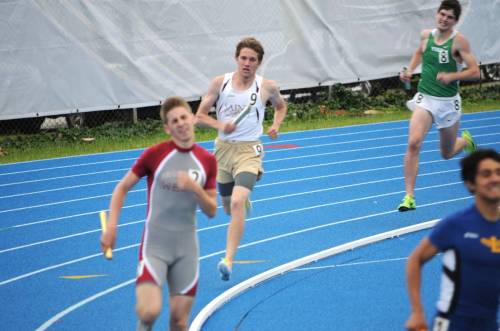
Chris Korabik held onto the ninth place medal position on the final straightaway as York chased. It was an important single point for the Wolfpack. Photo by Steven Bugarin.
But it wasn’t to be. Kampe, moved to the first leg so that he could sit behind the pack for the first lap and then try to move as he likes to do with 300 meters to go, did just that—but again he struggled on the last 100 meters. At 2:00.5 we were behind the pack at the first exchange. Gibson caught up quickly to the back of pack and then relaxed. His 400 split was reasonable—about 56 seconds. At the 300 mark he surged, moving into the middle of the pack. Then he, too, struggled in the last 100 meters, finishing in 1:57.9. It was a similar story for Reardon. He caught up. Then he moved, but then he struggled, having used his resources to get himelf back into the race. Reardon passed the baton to Korabik in eighth place at 5:56.6 after a 1:58.4 leg. Chasing the fast anchor leg runners, Korabik never really got back into the mix. He was passed by one runner; he came through the first lap in 57 second seconds still in ninth. He held onto the final medal position down the last straightaway with a 1:58.1 leg as the anchor from York tried to run him down. Our final time was a tick slower than the day before: 7:54.85.
Barrington had won in 7:45.94, so we never had a chance to win. But sixth place LaGrange Lyons Township finished in 7:52.23. We scored one point in ninth place; sixth place would have been worth four—and we had been hoping for five. But it would turn out to be an important point at the end of the day, nonethless.
We were on top of the moving schedule, and Jack Keelan was in the tent plenty early for the 3200. Last year, when Keelan attempted the 3200/1600 double, we had come to the state meet with a simple strategy. He would try to run the final two laps of all three of his races, 1600 prelims, 3200, and 1600 final in 2:05 or better. If he could do that, we felt, he would have a chance in all three races. As it turned out, perhaps because of the hot weather which produced 100 degree temperatures on the track, he couldn’t. Malachy Schrobilgen of Oak Park-River Forest, did manage that feat in the 3200 as he ran away from Keelan in the last two laps to win in 9:03.42 and Keelan finished second in 9:08.48. But even Schrobilgen found himself in survival mode in the 1600 later in the day as he finished third behind New Trier’s Leland Later, who had run only the 1600; Keelan had gamely finished seventh.

Jack Keelan’s plan in the 3200 was to sit in the pack for five laps–and then take control of the race. Photo by Steven Bugarin.
As we prepared for this year’s meet, we looked at the forecast to see that the cool temperatures would help Keelan attempt the 3200/1600 double. The announced strategy would be the same, and no surprise to anyone who had watched Keelan’s race at the Arcadia Invite in early April, where he had run the state leading time for 3200, 8:50.74. Keelan had simply bided his time at the back of the big Arcadia pack of 25 runners for the entire first five laps; then he had moved halfway up the pack on lap six, and then further up on lap seven. He had in fact taken the lead briefly as the race entered the final lap. There he had let eight runners go by him, although he had passed three of them back before his fifth-place finish. After a 4:36 first mile, his final mile had been 4:14—and a 2:03 final half mile. Once again, we decided, he would need to run that 2:05 in the last half mile at the state meet to win—and this year the heat would not suck that finish out of him in the earlier laps.
But as we neared race day, Keelan also decided to amend the plan.
Text messages with his friend Alex Riba at O’Fallon confirmed that Riba and his teammate Patrick Perrier would be running the 3200/1600 double just like Keelan. Riba had led Keelan for most of the IHSA state championship cross country race back in November, before Keelan made his move with 800 meters to go and left Riba behind. A week later, at the NXN regional in Terra Haute, Keelan had attempted the same move—but he didn’t have the same engine. Riba and three others held onto Keelan and then Riba won the race with a strong finishing kick. Initially fierce rivals who had hardly even spoken, one from the north of Illinois and one from the south, Riba and Keelan had become friends in Portland as members of the Midwest team. But in Charleston they would still be racing.

When Alex Riba took the lead of the 3200 after the halfway point, Keelan moved to follow. Photo by Steven Bugarin.
Keelan’s new plan was really just a variation. Although he had new confidence in his finishing kick, Keelan decided he would take the lead of the state 3200-meter with three laps to go and push the pace from there. Assuming that Riba and Perrier did not try to pull out ahead of the pack on their own, in which case Keelan would likely follow them, Keelan would sit in the pack for five laps—and then he would push the pace. It sounded good to me, I said. In the Tour-de-France, I told him, they would call it a selection. It was clear that it would be a deep field, with lots of boys who might think they could run close to 9:00 under good conditions. It would be better if at the end the race came down to fewer competitors so Keelan could know who he was racing. An earlier move would drop people before the end game. He was thinking a 65 lap would be about right.
The race went pretty much according to Keelan’s plan. The pace was a little bit slow—2:19 at 800, 3:39 at 1200, 4:39 for Keelan at 1600. And still he sat in the pack in about tenth place. Lurking behind him for all three laps were Riba and Perrier. Just before the mile, Riba shot past on the outside. Keelan quickly followed and jumped into the open space behind Riba in second. Perrier soon followed Keelan. Riba took the now strung out line of runners through a 65-second lap. As they entered the home straightaway at the end of lap five, Keelan stuck with his plan. He moved past Riba into the lead. He would try to control the race from the front. Cue the Prefontaine music.
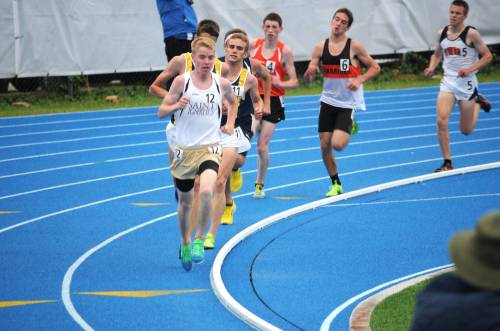
Keelan took control of the race on the sixth lap, according to his plan. Photo by Steven Bugarin.
Lap six wasn’t a 65, but more like a 67. It strung out the field, but it wasn’t really a selection. When Keelan moved, though, Perrier and Riba jumped in behind him. Tyler Yunk from Belevidere North, who in fact had the second best personal best coming into the race at 9:03, fought his way back to hook on behind the front three. Game on.
Lap seven wasn’t a lot faster—a 66. I had a moment of doubt. Maybe Jack wasn’t feeling great. The move hadn’t really been decisive enough. Or maybe he was just really confident. He was leaving it to the last lap.
Keelan, Perrier, and Riba pulled away from the line of runners around the turn going into the last 400. Then Perrier passed Keelan coming out of the turn. Everyone knows that Perrier and Riba are faster 800 meter runners than Keelan. Perhaps the pace had not been demanding enough to put that speed away. Maybe it was Prefontaine music?
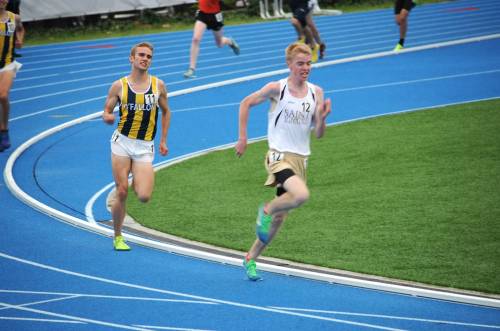
Alex Riba challenged on the last straight, but Keelan had the better finishing kick. Photo by Steven Bugarin.
But it was only a moment of doubt. Keelan gave Perrier a few meters in the lead, and then he lowered his head and started to move around him on the outside. Perrier fought for a moment, then gave in. Keelan hit another gear and left him behind. 200 to go and Keelan was sailing in the lead—but it had only been a 31 second 200. He should have plenty left. Riba, meanwhile, moved past Perrier and started after Keelan going into the last turn.
He gained a little bit, then a little bit more. And then Keelan hit the after-burners and left Riba behind. The last 200 was 27.5 seconds on my watch.
The official time was 8:57.61. Riba also went under 9:00. The last 1600 was 4:18. The last 1200 was 3:13. The last 800 was 2:06, so Keelan had left it a little bit late. The last 400 was 59 seconds.
It had already been several trips back and forth to the field house. I had watched both races in the stands, down front at the start of the home straightaway, with our team. Keelan’s plan, even with the original meet schedule, had been to return directly to his dorm room after the 3200—skipping the medal ceremony.
He had asked freshman Dan Santino to stand in for him, kind of a changing of the guard, perhaps. Santino missed qualifying in the 3200 at the sectional meet by 4/10s of a second, running the fastest time for a freshman in Illinois this year, 9:29.65. I walked Santino down to the track entrance and ushered him through. There was no sign of Keelan anywhere.
Then I went to the field house. I texted assistant coach Steven Bugarin in the stands: “I’m in the field house. Where is Conor? Send him here.” Earlier in the day we had texted and tweeted to everyone the news that the meet would accelerate. How did coaches manage this kind of situation before cell phones and texting, I wondered?
I got a text from the press box, where our girls assistant coach Matt Haffner was helping do the computer work for the IHSA. “Team is in second.” It gave me a chuckle, as I figured it out. They had given out the shot put awards. There had been three events on the track. So after four events, we were no doubt one of the only teams to score in two, and with Keelan’s ten and one from the 4×800, we had 11.
Dunham appeared—and I told him were in second place with 11 points. He chuckled, too.
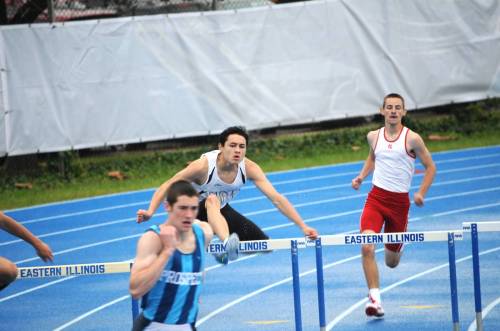
Conor Dunham was a surprise third place finisher in the 300-meter hurdles, putting the Wolfpack in contention for a trophy. Photo by Steven Bugarin.
Then he was a little bit surprised that I told him he had only 20 minutes to warm up before they would want him in the tent for the 300 hurdles. He got to work. He seemed especially calm, focused, and confident. I walked him all the way to the tent and watched him safely inside as the last of the 400 heats was finishing.
Back in the field house again, I got a text from the press box, where our girls head coach, Erin Luby, was visiting with Haffner. I had tweeted earlier that Keelan was back in the dorm while Dunham warmed up. “Is Keelan still in the dorm?” Luby texted. “The meet is 90 minutes ahead of schedule.”
Text to Keelan, text to his father who was with him back at the dorm. Keelan was already on his way. He appeared in the field house shortly as the 1A 300 heat began. He had already warmed up. I had given his father a clean, dry singlet for him to wear. Did he have it? Was his number on it? Yes, he was all set. He could get himself to the tent. Someone had told me, I said, that he had been a little bit “spent” after the 3200. He laughed a little bit and then set off to check in.
I was literally running through the track entrance on the east side grandstand as the gun went off for Dunham’s 300-meter hurdles race. They were coming off the first straightaway when I caught sight of Dunham in lane 3 chasing Dave Kendziera of Prospect in lane 4. He was a couple steps behind.
Dunham had been fifth in the prelims, running his fastest time of the year 39.11 seconds. Only once had he ever run faster—38.98 last year in the sectionals. The top three in the prelims were seniors—and very good ones: Kendziera, Andrew Helmin of Providence, and Lino Mogorovic of Lyons. They seemed untouchable. As Dunham’s father, Dan, had noted the night before when I said that something might happen in front of Conor to help him out, “These are seasoned guys. “
But in the prelims Dunham had been beaten by Lake Park sophomore Antonio Shinault. This was Shinault’s first trip to the state meet as a hurdler. Dunham had qualified as a freshman and then as a sophomore last year, when he had just missed qualifying for the final. Shinault, we thought, could be beaten. We were hoping for fourth.
Dunham looked fast around the turn, not losing much ground to the leaders in the middle lanes. At the last hurdle coming off the curve he hesitated, and then switched legs. Either he was in trouble, or he was going so fast he had outrun his usual step pattern. Dunham hesitated a little bit, not quite a stutter, coming to the first hurdle off the curve. He was in fourth.
Three weeks ago at the Nalley Invite he had been behind coming into the straightaway. He had lowered his head into a headwind and won the race.
Dunham started his charge again—and then Mogorovic hit a hurdle hard. Dunham shot ahead of him into third. He finished strong in a personal best and school record time of 38.26 seconds, scoring 7 points for the team.
I hurried to the main grandstand to watch the 1600 with our team, still sitting low in the stands at the start of the final straightaway.
Keelan’s1600 race came quickly; instead of three hours of rest as it was originally scheduled, he would have 90 minutes.
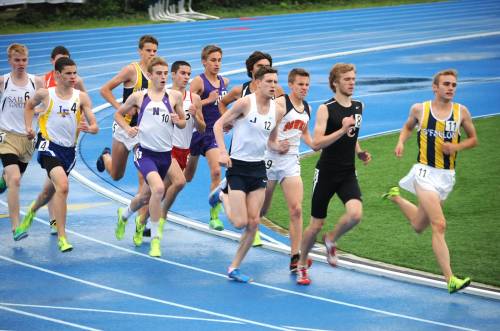
In the 1600, as in the 3200, Keelan took a spot back in the pack. Photo by Steven Bugarin.
Once again, as he had in the 3200 and in the prelims the day before, he settled toward the back of the pack for the first lap, keeping out of trouble. But Riba pushed to the front at around 200 meters, and taking precaution, Keelan moved quickly around the big pack on the home straightaway to get closer to the front. The first lap was a 64.
Riba kept the lead for the second lap. Coming down the home straight before the 800 meter mark, Jamison Dale of Jones College Prep, who had run the fastest time in the prelims the day before, 4:11.99, moved decisively into the lead. He was just under 2:08 at the 800. He moved out to around a fifteen meter lead on the rest of the runners.
Keelan accelerated to cover the move first, going by Riba; then others followed. Keelan let them pass, sticking to the inside curb. Entering the home straight again, Billy Bund of Lake Forest and Garrett Lee of Belvidere North pulled the whole group back up behind Dale. Keelan worked his way off his inside position on the curb as he went through the 1200 in fifth place, just a part of the chase group–but now on the outside of lane one with some room to move. Dale’s 1200 time was 3:12.

When Jamison Dale of Jones took the lead, Keelan moved to the front to stay close. Photo by Steven Bugarin.
Keelan still waited patiently. It could have been a dangerous situation with as many as eight runners still in the race. There had been no selection. With 300 to go the pace had really quickened. Dale fought off Bund to stay in the lead.

Keelan followed when Garrett Lee made his move with 200 meters to go. Photo by Steven Bugarin.
Down the back stretch, there was a large bunch of runners pushing toward the front of the race. Then from behind Keelan, Garrett Lee charged on the outside all the way to the lead past Dale and Bund. Keelan followed him, settling into second. Around the curve, they separated from the rest of the runners. At the start of the straightaway, Keelan hit his high gear again to leave Lee behind. Lee beat the rest of the pack for second. Keelan was 4:12.11, with a 59 second last 400, and a 28 second final 200.

Once again, Keelan had the better sprint finish. Photo by Steven Bugarin.
He had won the triple crown—cross country title in November, and then 1600 and 3200 in May. Maddie Perez of Glenbard West had accomplished the feat the previoius week; Grant Nykaza of Beecher had done it, as well, at the 1A level, just minutes before Keelan. But previously it had not happened since York’s Sean McNamara did it in 2004-5.
As a group the team decided to move to the award stand area, where both Dunham and Keelan would wait for a long time to get their medals. The meet had moved so quickly there was a backlog of awards to be presented.
Then another text from Haffner: “Your team is in second place.”
It did not last long. We watched Pekin’s Cole Henderson win the 200, his third final of the day—and his third first place win, after the 100 meters and long jump. With his ninth place finish in the 400, Henderson by himself totaled 31 points for Pekin—and he took over second place.
In the awards area, we watched the 4x400s. Nothing happened with the points distribution in the 3A race to change the standings. It had become apparent that many teams had split the points for the meet’s first 16 events. And after 16 events, Ignatius, improbably, was still in third place with 28 points.
We watched Dunham get his medal on the award stand. Then Keelan got his medal, this time standing in for himself.
The announcement came that bigger storms were threatening the area, and the IHSA would not conduct a trophy ceremony at the end of the meet.
I had been in the field house with Keelan and Dunham when activity began to move the 3A pole vault competition indoors. We knew that was where the meet would end, and the team began to head in that direction.
In the field house, the atmosphere was subdued at first, but it would become electric. It was 2:30, the track events were over, but the pole vault had just barely begun. The 2A high jump competition, also moved indoors, was just finishing. The 3A high jump competition was waiting to start.

Conor Dunham gets his third place medal on the awards stand. Photo by Steven Bugarin.
Our Ignatius group began to assemble. Large numbers from the Keelan family arrived. Karamath Khan, Ignatius class of 1984, had come down to Charleston to watch with his son Kallin, a sophomore member of our team. The Santino family was there. And then there were also the boys from our team.
It would be a long vigil. We sent the freshmen, who somehow had never checked out of their dorm room, back to the dorm to pack up. Steven Bugarin, our assistant coach and team photographer, got the job to supervise. Then we watched the high jump and the pole vault progress.
Senior Ray Lewis, who had driven himself to Charleston and taken his own room in a spectator dormitory, began to calculate possible point totals for the teams who still had competitors jumping. O’Fallon would be able to pass us because they had two pole vaulters in the competition. There was an Edwardsville high jumper, as well.
But we all knew the bigger and more inevitable threat to our trophy hopes. Providence Catholic, our Chicago Catholic League rival, entered the competition with the top high jumper, Mike Monroe, and top pole vaulter, Chad Weaver, according to the sectional seeds. With Andrew Helmin’s 18 points from the two hurdles races, they could score as many as 38 points. I had a short conversation with the Providence coaches, who were watching the high jump most intently. There were still ten high jumpers in the competition, and ten pole vaulters. They were confident, but also realistic. “We could get twenty,” said one coach. “But we could get zero.”
The field house had become meet central. Mike Newman of Dyestat Illinois came through, sought out Jack Keelan, and joked that it was 2:30 and Jack should be warming up for the 1600.
Assistant Coach Ike Ofor showed me how to do a screen shot on my Iphone. I took a shot of the IHSA results page with team scores after 16 events, which showed Ignatius still in third place. Later I would take another one after 17 events; we were still in third. All told, we held onto the third place trophy from 1:30 until 4:30 or so.
As the Providence jumper and vaulter cleared heights, it became a little bit painful to watch. Monroe needed to clear one height, with a number of jumpers still going, on a third attempt; I don’t remember exactly which one, or whether it would really have mattered. But when he cleared on the third attempt, that was clearly the end of trophy hopes for us. Essentially each time Monroe or Weaver cleared a height, it was another point or two for Providence. Weaver was flying confidently over the pole vault crossbar each time, really leaving no doubt.
The Edwardsville high jumper went out at 6 foot and 5 inches for seventh place; that left Edwardsville behind us with 26 points. The two O’Fallon vaulters were now a threat to our fourth place position. Our pole vault coach Pat Boyle said that when they cleared 14-06 they were already jumping above their personal bests. But they were fighting for their team, trying to get their team on the podium. They were clearly disappointed when they both missed three times at 14-09. They scored three points together as the eighth and ninth place finishers. O’Fallon would finish behind us with 27 points.
In the end, Weaver would finish third and Monroe second in their events to score 15 points and earn Providence the second place trophy with 33 points, ahead of Pekin’s one man team Cole Henderson. Jonathan Wells of Grant-Fox Lake would win the high jump at 6-11; those 10 points moved his team into a tie with us for fourth place at 28 points.
At whatever point it had become clear that Providence would pass us, we began conversations about leaving Charleston. A big group of our boys who were still with us waiting for the trip home—several went home with their own parents—decided to make a postponed visit to the First to the Finish tent nearby where the boys always enjoy buying the leftover team jerseys on sale there each year. Pat Boyle wanted to wait to see if Luke Winder of Plainfield Central, winner of the pole vault at 16-03, would be able to clear 17-00. We almost left him behind in the field house.
As we assembled in the parking lot outside the field house and stadium, a Jimmy John’s car drove up. A woman driver jumped out and asked if we wanted some free sandwiches. How many of us were there? About 15. “How about 30, then,” she said. “They are pretty small.”
I had missed eating lunch. The little ham sandwich was good. We didn’t win a trophy, but we got free sandwiches.
We stage our trip home to Chicago each year, in what has become a team routine if not a tradition, with a stop in Champaign at the Steak and Shake on Neal Street north of I-74. We arrived to find the Keelans and Santinos already there.
I checked my email on the Iphone. Congratulations had come in from a number of people who had been following the meet online or by our twitter feeds.
Tim Mitchell, Keelan’s immersion service teacher, wrote me that I should tell Keelan he would deliver a vintage yellow St. Ignatius warm up jacket to me on Tuesday. Mitchell, who will move to teach at Loyola Acadmey next year, is giving away some of his old Ignatius coaching gear. He had promised Keelan the prized jacket if he won in Charleston.
Over the next day or so there were more congratulatory notes. Best of all, perhaps, was a note from Ignatius alumnus and parent Pete Connelly, girls track and cross country coach at Montini High School—and son of Hall of Fame Ignatius coach Jim Connelly, who died late last summer. We had made the Connelly family and Saint Ignatius track community proud, he said. After looking at the IHSA results after the track events had ended, he had spent a day bragging to people about our third place finish.
After he figured out his mistake, he said, he continued to brag about our fourth place finish.

Jack Keelan on the awards stand gets his 1600 meter medal. Photo by Steven Bugarin.
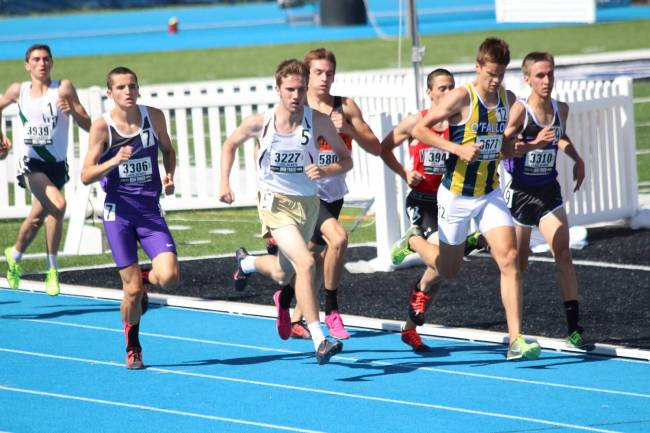




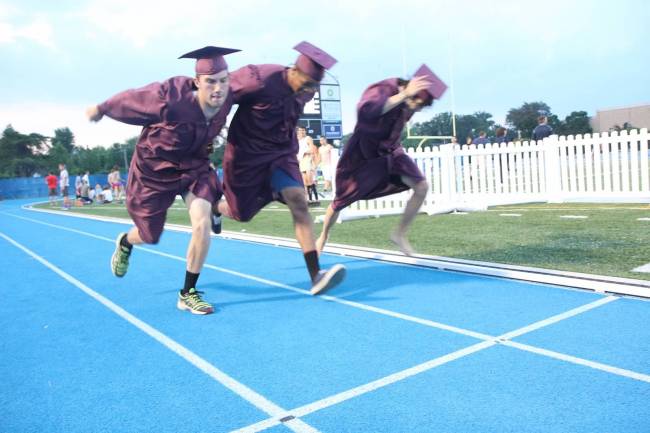
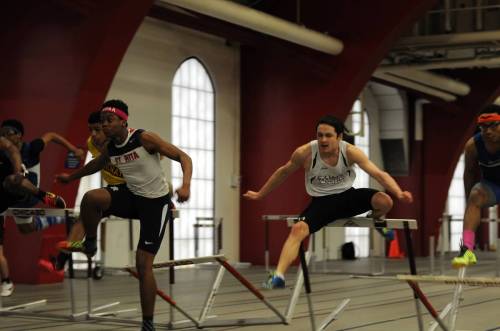


 Before the start of the Jesuit Invite at Georgetown Preparatory School outside of Washington, DC, on Friday, February 21, sophomore Dan Santino approached Saint Ignatius alumnus Tom O’Hara, class of 1960, near the small grandstand beside the main straightaway. After they had been introduced, Santino politely asked O’Hara a question: “What did it feel like to set a world record?”
Before the start of the Jesuit Invite at Georgetown Preparatory School outside of Washington, DC, on Friday, February 21, sophomore Dan Santino approached Saint Ignatius alumnus Tom O’Hara, class of 1960, near the small grandstand beside the main straightaway. After they had been introduced, Santino politely asked O’Hara a question: “What did it feel like to set a world record?”